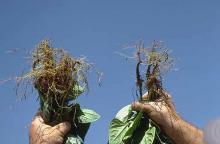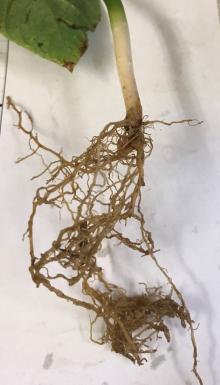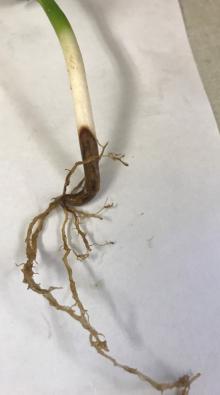Cause The fungus, Fusarium solani f. sp. phaseoli, can survive in soil for many years. It persists on infected bean straw and spreads when the straw is moved. Wind and water can move infested soil and debris. The disease is favored by extremes in soil moisture (too dry or too wet) and is less severe when moisture is near field capacity. Anything, which impedes root growth such as cold or compacted soils also favors the disease.
Symptoms The main root may show a red discoloration, later turning brown and decaying. Infections seldom spread into tissues above ground level. Small side roots die and, above them, secondary roots develop, which may become infected and die. These secondary roots help maintain the plant and help the crop develop when the tap root is severely diseased. In severe cases, plants are stunted; leaves are yellowish and often drop early.
Cultural control
- Plant in well-drained soil when possible.
- Avoid compacted soils or minimize soil compaction with deep ripping to avoid hard pans.
- Rotate into grass or small grain crops between bean crops, 5 to 6 years is better but 3 to 4 year rotations are more common.
- Till 18 inches below the row just before planting. Root rot is not decreased, but better root formation offsets the disease's effect on the plant. This treatment is especially effective on heavy soils or in soils that have a plow pan.
- Hilling vines is helpful because it promotes adventitious root production.
- Use resistant or tolerant varieties if available.
Biological control Efficacy of the following products in the Pacific Northwest is unknown.
- Amplitude ST at 2 to 8 fl oz/100 lb seeds. 4-hr reentry. O
- Bexfond at 7 to 14 fl oz/A. 4-hr reentry. O
- Mycostop at 0.07 oz/lb seed. 4-hr reentry. O
- Stargus at 6 to 8 fl oz per 1,000 ft row as an in-furrow treatment. Preharvest interval is 0 days. 4-hr reentry. O





